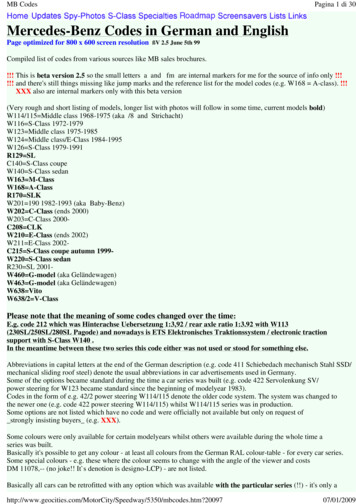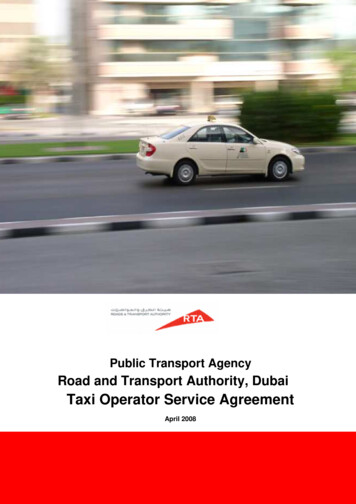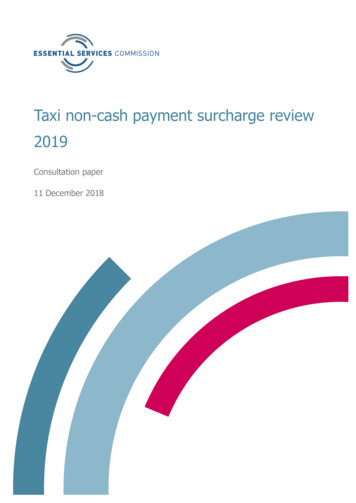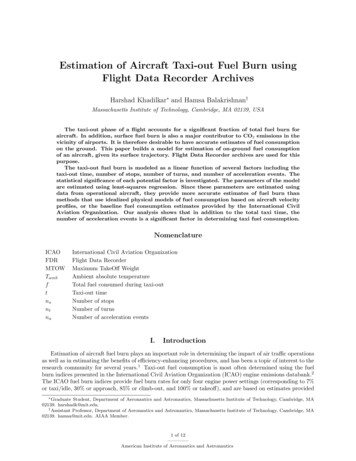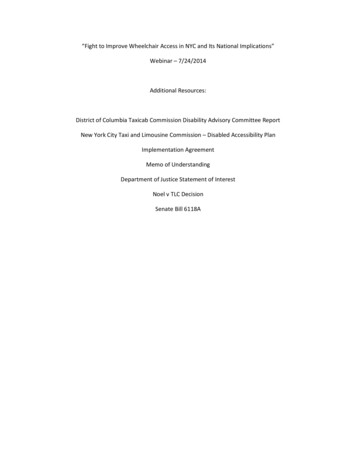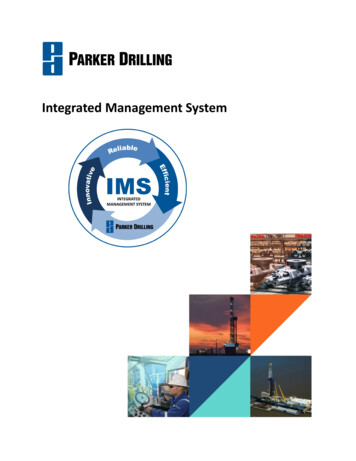
Transcription
AN INTEGRATED TAXI MANAGEMENT INFORMATION SYSTEM MODELFOR KAMPALA TAXI OWNERS AND DRIVERS ASSOCIATIONBIZOZA KOMAYOMBI SERGEMASTERS OF SCIENCE IN INFORMATION TECHNOLOGY(Information Systems)SEPTEMBER, 2018
AN INTEGRATED TAXI MANAGEMENT INFORMATION SYSTEM MODELFOR KAMPALA TAXI OWNERS AND DRIVERS ASSOCIATIONBIZOZA KOMAYOMBI SERGE17/MSI/BU/G/1003A Thesis submitted to the School of Graduate Studies Bugema University, in partialfulfillment of the requirements for the award of Masters of Science in InformationTechnology (Information Systems), Bugema University. KampalaSEPTEMBER, 2018ii
ACCEPTENCE SHEETThis thesis entitled “AN INTEGRATED TAXI MANAGEMENT RSASSOCIATION.”, prepared and submitted by BIZOZA KOMAYOMBI SERGE inpartial fulfillment of the requirement for a degree of MASTER OF INFORMATIONTECHNOLOGY (Information Systems), is hereby accepted.FRANCIS Lowu, MSCMember, Advisory CommitteeDate SignedDavid Mpanga, MSCMember, Advisory CommitteeDate SignedDr. Samali V. Mlay, PhDChairperson, Advisory CommitteeDate SignedChairperson, External Examining CommitteeDate SignedMember, Internal Examining CommitteeDate SignedAccepted as partial fulfillment of the requirement for a degree of MASTER OFINFORMATION TECHNOLOGY (Information Systems), Bugema UniversityChairperson, Department of BusinessDate SignedRosette Kabuye, PhDDean, School of Graduate StudiesDate Signedi
DECLARATIONI, BIZOZA KOMAYOMBI SERGE, hereby declare that this thesis titled “ANINTEGRATED TAXI MANAGEMENT INFORMATION SYSTEM MODEL FORKAMPALA TAXI OWNERS AND DRIVERS ASSOCIATION” is original and aresult of my own study and not been submitted for an award of degree in any otheruniversity of institute of higher learning.Signature: .BIZOZA KOMAYOMBI SERGEDate: .ii
DEDICATIONThis thesis is dedicated to all my lectures, my parents, Mr. KOMAYOMBIMUGWIZA Mamert and Mrs. TIMIZA MUGABO Henriette, and my dear sistersLaetitia Sine, Nadia Komayombi, Isabelle Mugwiza, Nancy Mugwiza, Agatha Mugwizaand my brothers Fernand Mugwiza Benjamin Mugwiza and Joseph Mugwiza, thank youso much for the love, supportive prayers and role in my life, May the lord continue tobless us all the time.iii
BIOGRAPHICAL SKETCHThe author of this thesis is Bizoza Komayombi Serge, born on 27 th/07/1990 inGoma / Democratic Republic of Congo. He completed his primary school in 2002 inComplexe Scolaire KABUIS then joined ISIDORE BAKANJA Institute for hissecondary school, which he completed in 2010.In 2011, he joined Bugema University for his Bachelor’s Degree in ComputerNetwork and System Administration and graduated in 2014.In 2014, he worked in INFOSET in the department of payment system. In August2016, he applied for Master’s Degree of Information Systems at Bugema University.iv
v
AKNOWLEDGEMENTSFirst, I would like to thank the Almighty God to give me all the resources I neededevery day to complete this work wisdom, strength, and inspiration. Without His unlimitedpower, guidance and good health, I would not complete this thesis.I thank all my family for their financial, spiritual support and their care that helpedme to achieve the completion of this thesis. May God bless all and everyone abundantly.In the special way, I extend my sincere thanks and gratitude to Mr. Francis Lowu,Mr. David Mpanga and my chief supervisor DR. Samali Mlay for the advices, comments,constructive critics and guidance. May God bless you all abundantly. I also thank for their timely encouragement and guidance when going through the process of writingthis thesis.I am also grateful to all my lectures, Mr. Onyango Laban, Mr. Muwanga Kosea forthe unlimited knowledge and practical instructed in me during all my learning process atBugema University. I cannot also forget all the staff members of Bugema University, forthe support and encouragement. May God bless you all.At last, I will not complete this part without giving thanks to my fellow colleaguesand friends, Mrs. Butoto Birenzi, Mr. Odiya Philip, Mr. Elvis Charles, Mr. SimaliAnthony, Mr. Birumi Timothy, Mr. Woira Jerrie, Mr. Ivan Manirabona, Mr. Boris Nama,Mr. Sonny Sammuel, Mr. Steven, Mr. Mugerwa who have always been there for mewhen I needed clarifications and support during hard time and good time, God bless youall for accepting me to be as a friend and brother while at Bugema University.vi
TABLE OF CONTENTSPAGEACCEPTENCE SHEET.iDECLARATION.iiDEDICATION.iiiBIOGRAPHICAL SKETCH.ivAKNOWLEDGEMENTS.vLIST OF TABLES.viiiLIST OF FIGURES.ixLIST OF APPENDICES.xLIST OF ACRONYMS.xiABSTRACT.xiiCHAPTER ONE.1INTRODUCTION.1Background of the Study.1Statement of the Problem.3General Objective.3Research Questions.4Specific Objectives.4Scope of the Study.4Justification.5Conceptual Design.5Operational Definition of Terms.6CHAPTER TWO.7LITERATURE REVIEW.7Introduction.7The role of information technology in the transportation sector.7Analysis and design of taxi management systems.8Related taxi management systems and models.9Summary of Identified Gaps.11CHAPTER THREE.12METHODOLOGY.12Research design.12Local of the study.12Population and Sample Size.12Sampling Procedure.12Research Instruments.13Requirements Gathering Procedure.13Requirements Analysis.14Development, Validation and Testing.14vii
PAGECHAPTER FOUR.15ANALYSIS AND DESIGN OF ITMISM FOR KATODA.15Analysis of Requirements.15Analysis of Results.16Requirements Specification.18Functional requirements.18The system should perform the following tasks:.18Non-functional requirements.18Design of the Models.19Context Diagram (level 0).19Use case diagram.20Architectural diagram for the integrated taxi management information system model.21Data Flow Diagram (Level One).21An Integrated taxi management information system model for Kampala taxi ownersand drivers association.23Entity Relationship Diagram (ERD).24CHAPTER FIVE.26WORKING PROTOTYPE OF THE SYSTEM.26Prototype Development.26System Interfaces.26System Testing.30Validation.30CHAPTER SIX.32SUMMARY, CONCLUSIONS AND RECOMMENDATIONS.32Research n.33REFERENCES.34APPENDICES.36viii
LIST OF TABLESTABLEPAGETable 1: Proposed user requirements of the system model.16ix
LIST OF FIGURESFIGUREPAGEFigure 1: Conceptual Design.5Figure 2: Graphical Representation of user Requirements.17Figure 3: The Context Diagram.19Figure 4: The use case diagram.20Figure 5: Architectural diagram.21Figure 6: Data Flow Diagram.22Figure 7: System model.23Figure 8: Entity Relationship Diagram.24Figure 9: Sequential Diagram.25Figure 10: Prototype Login Page.26Figure 11: Prototype Dashboard.27Figure 12: Manage Users Interface.27Figure 13: Drivers Module.28Figure 14: Vehicles / Taxi Module.29Figure 15: Manage Expenses Module.29Figure 16: Manage Income Module.30Figure 17: Login Authentication.31x
LIST OF APPENDICESAPPENDIXPAGEAppendix 1: Interview Guide.36Appendix 2: Approval letter for requirements collection.38Appendix 3: Login Codes.39xi
LIST OF ACRONYMSKATODA:Kampala Taxi Owners and Drivers AssociationICT:Information Communication TechnologyERD:Entity Relationship Diagramxii
ABSTRACTBIZOZA KOMAYOMBI SERGE, School of Graduate Studies, NINTEGRATEDTAXIMANAGEMENT INFORMATION SYSTEM MODEL FOR KAMPALA TAXIOWNERS AND DRIVERS ASSOCIATION.”Supervisor: Samali V. Mlay, Ph.D.The researcher conducted the study to develop an integrated taxi managementinformation system model for Kampala taxi owners and drivers association (KATODA).The main objective of this research was to design a model of an integrated taximanagement information system model for Kampala taxi owners and drivers association.To fulfill that objective, the researcher carried out requirements gathering and analysis toobtain the functional and nonfunctional requirements for the system.An interview method was used with the help of interview guides to gather datafrom the respondents and content analysis was used to analyze the qualitative data andrequirements needed for the designing of the model where noted. The researcherdesigned the model using UML modeling tool (Microsoft Visio) and MySQL an opensource Relational Database Management System. The integrated managementinformation system model shows how the operators in the Kampala taxi owners anddrivers association register taxis and taxi drivers for each vehicle. The operators alsomanage income and expenditure within the association.xiii
CHAPTER ONEINTRODUCTIONBackground of the StudyAll over the world, the popular mode of transportation is by use of taxis in mostof the cities. The costs of owning a private vehicle are high and therefore, taxis serve animportant and an alternative purpose in the transportation sector. Quality customerservice requires fast and efficient means because the taxi industry is very competitive(Jing, et al., 2014). There are several taxi management systems including those that aresatellite-based, to track taxis using Global Positioning System (GPS) technology. Taxicompanies deploy currently such systems, mainly in the capital cities of developedcountries. With these systems, taxi companies can track, locate, and dispatch taxis on theroad network in real-time (Jing, et al., 2014).Choudhary (2013) explains that, automating the taxi transportation is becomingmore important because, automated systems provide accurate information about taxiessuch as registration, fare charges, road information, and taxi information. Thisinformation is from anywhere and at any time.Furthermore, Choudhary (2013) adds that Information Management Systems areable to provide detailed information to commuters, taxi owners, and drivers. In addition,the systems efficiently and effectively manage the income and expenses for taxi ownersand operators from the taxi companies.In developing countries, taxis play numerous roles that are essential indevelopment of the cities economically, much as they face severe challenges. Taxis canlocate passengers at exact locations because they are flexible (Veloso et al., 2011). This1
means that, the services taxis provide are flexible and easily accessible in terms or routeoperation, unlike other means of transport such as trains, buses, boats, and ships. Taxishave already become an essential part of our lives; particularly you are in hurry and inneed of an urgent means of transport. During such emergencies, public transport is slowand inconvenient. More so, there are particular places where public means of transport donot fit because the roads are not main. In those areas, people may require walking longdistances in order to reach the main roads and access the public means of transport, yettaxis can reach even in the feeder roads. Other factors hinder the usage of personal cars,such as insecurity to owners of the personal vehicles, lack of parking, traffic congestionand poorly constructed roads. A taxi offers a better option in all these situations onaddition to other available means of transport (Rayle et al., 2014).Much as taxis are vital and appropriate in the transportation sector for developingcountries, associations responsible for managing their services operate in an informal andunorganized manner. According to Kisembo (2014), taxi associations in Ugandaincluding Kampala Taxi Owners and Drivers Association (KATODA) maintain littlerecords about taxi drivers, taxi owners, taxi fares, taxes, and income and expenditurewithin the association. Because of this poor management of taxi services, there are highresponse times while retrieving records, higher charges to taxi drivers, inaccurateaccountability of income and expenses in the organization, hence lower earnings andlosses.It is against this background that the research purposes at developing an integratedtaxi management information system for Kampala Taxi Owners and Drivers association.The researcher noted that KATODA could improve its managerial services in the2
transportation industry if they deploy as system to automate and integrate their processesinvolved in various modules.Statement of the ProblemPoor service delivery continues to escalate in the transportation sector in Uganda.Taxi governing bodies perform in an informal and unorganized manner leading to lowerearnings and losses among the taxi drivers, taxi owners, and the governing bodies(Kayemba, 2013). Currently, Kampala Taxi Owners and Drivers association (KATODA)are using manual means to record the registration of taxis, taxi owners, and drivers, onpaper. As a result, they face a challenge of retrieving the information in time and in anorganized way, whenever required. In addition, KATODA has no formal way trackingthe internal expenses and income, and hence finds challenges to deliver accurate reportsto the governing authority, Kampala City Council Authority. Due to these inefficienciesand ineffectiveness, taxi owners and drivers are sometimes over charged and someincome is miss used, hence the need to a system to address all the challenges.General ObjectiveThe general objective of the research is to develop an integrated taxi managementinformation system model for Kampala Taxi Owners and Drivers Association to enableeasy registration and recognition of all the taxi drivers, taxi owners, and their vehiclesactive in Kampala and for easy monitoring, managements of expenses and reporting.3
Research Questions1. What processes and specifications does the integrated taxi managementinformation system for Kampala taxi owners and drivers association, require?2. What modules and components does design for the integrated taxi managementinformation system model for Kampala Taxi owners and drivers association,constitute?3. How shall the integrated taxi management information system model for Kampalataxi owners and drivers, be tested, and validated?Specific ObjectivesThe following specific objectives guide the research study:1. To gather requirements necessary to design an integrated taxi managementinformation system model for Kampala Taxi Owners and Drivers association andanalyze them to obtain system specifications2. To design an integrated taxi management information system model for KampalaTaxi Owners and Drivers association.3. To develop an integrated taxi management information system for Kampala TaxiOwners and Drivers association, in order to test and validate the model.Scope of the StudyThis research focused on developing an integrated taxi management informationsystem model for Kampala Taxi Owners and Drivers Association. The model hasmodules to register users, taxi owners, taxi drivers, and vehicles, manage the sittings ofthe system, manage KATODA income and expenditure, and generate reports. The model4
called integrated because it connects all the distinct modules within KATODA into onesystem.The researcher carried out the study within a period of five months, and developeda working prototype for an integrated taxi management information system model, to testand validate the model.The researcher carried out the study in the central region of Uganda, Kampala. TheKampala Taxi Owners and Drivers Association (KATODA) own the integrated taximanagement information system and are fully responsible to manage it if implemented.JustificationThe study was to expose the inherent situations of an integrated taxi managementinformation system in Kampala, thus was an eye opener to the taxi owners, their vehiclesand drivers how they were registered in different groups and to identify the ideal incomeand outcome per number of taxies active in the system,The study pointed out the intensity of the gaps within the current practices thus assistingthe key stakeholders to design the appropriate policies and measures towards addressingthe problem.Conceptual DesignTaxi DriverTaxi OwnerIntegrated ISModel5KATODA Operator
Figure 1: Conceptual DesignOperational Definition of TermsIntegrated Information system model: An information system is an organizedsystem that captures, transmits, stores, retrieves, manipulates, or displays information,there by supporting people, organizations, or other software systems.Taxi driver: This is the individual driving a taxi, he can be able to register himselfin the system, and he is assigned to a particular vehicle and taxi owner.Taxi owner: This individual owns a taxi vehicle registered in the integratedsystem. They can view the personal details can be viewed through the system by the taxiowners and drivers operators. He can also be able to register taxi driversTaxi drivers and owner’s association: It is a group of many taxi drivers andowners of the taxis who share information in the system.Model: A model is a working representation of a product or information system,usually built for demonstration purposes or as part of the development processIntegration: According to the study, integration is bringing related informationtogether in one central point.6
CHAPTER TWOLITERATURE REVIEWIntroductionThis chapter outlines and discusses in details the related literature on taximanagement systems and models by various authors who researched about this field ofstudy. It includes research from books, journals, research papers, articles, websites andother sources found relevant. The literature investigates the role of informationtechnology in the transportation sector, analysis, and design of taxi management systems,development and implementation of taxi management systems, related taxi managementsystems and models, and the summary of identified gaps.The role of information technology in the transportation sectorRayle, et al. (2014), explains that information and communication technologies(ICT) deliver intelligent solutions that play a great role in solving significant challengesthat societies face in the transportation sector. Intelligent systems guide drivers to drivesafely and avoid accidents, and even in case of a crush, these systems can call emergencyservices automatically. Intelligent systems in the transportation sector also reducepollution.According to Marin (2006), a taxi service is a thriving industry and therefore, theintroduction of information technology would be advantageous. Cost effective, efficient,and compatible taxi management systems would have a high market potential. Therefore,this would help taxis to be safer hence improving the transportation sector as a whole.According to Glaschenko, et al. (2009), the popularity of vehicle applications isincreasing in western countries, and smartphone technology is increasingly penetrating7
the industry. Several modern systems for transportation exist, such as dispatchingsystems most of which are hosted in a public cloud. In addition, companies that rent theirtaxis for commercial usage need advanced vehicle tracking systems on every vehicle.These systems help the companies to manage their whole business in an accurate andeasy way. With such systems, companies are able to track their vehicles whenever theyare sent for any booking. More so, they can monitor not only of the vehicles, but also thedrivers and the passengers with the aid of the vehicle tracking systems (Gerdes &Schaper, 2015).Furthermore, Glaschenko, et al. (2009) adds that in a fleet business, both thevehicles and the drivers are very important for the organization. Therefore, both of themmust be taken good care of. Using the advanced Vehicle Tracking systems, theorganization can do this with ease. It is easy to understand where the vehicle and thedriver are. In case it is difficult for the company to communicate directly to the driverover the mobile phone, then you the location of the vehicle can be tracked. In so doing,the company is able to ensure the safety of both the vehicle and the driver, and can findthem easily.In addition, taxi management systems are good for diagnosis of the vehicles aswell. They can help you to get sufficient information regarding fuel consumption alongwith the mileage of your vehicle. This helps to be aware of the efficiency of your cars ifrequired, take the necessary steps as soon as possible to repair them (Idris et al., 2002).Analysis and design of taxi management systemsGenerally, all information systems, including taxi management informationSystems are based on the conceptualization of the three fundamental iterative phases.8
These include data input, data management, and data output. Data input is the phase thatincludes acquisition and verification of data. Data management or processing is the phasethat includes retrieval and presentation of data (Tan, 2010).Just like any information system, developing a taxi management informationsystem is based on the analysis of the system. Analysis directly affects the databaseutility of the system. Database analysis is categorized into two parts. The first part is theanalysis of conceptual model, the second part is analysis of the logical model (Feng &Liu, 2013).Conceptual model is the generalization and abstraction of the real world. Thismodel reflects the real world relations between things and to satisfy processingrequirements of the user's data. The Entity Relationship diagram (ERD) is the powerfultool for designing the Conceptual model. Entity relationship model is problem-orientedconceptual model, and uses a graphical way to describe data of the real world. Toestablish the final system, the conceptual model has to be converted into a logical modeland this completes the design of the database logical structure. The design of the databaselogic structure involves two steps: First step is to convert the entity relationship diagramto the entity-relationship model, and then optimize the entity-relationship model. Oncethe database model is designed, then system design can start (Feng &Liu, 2013).Related taxi management systems and modelsAn agent-based simulation
ACCEPTENCE SHEET This thesis entitled "AN INTEGRATED TAXI MANAGEMENT INFORMATION SYSTEM MODEL FOR KAMPALA TAXI OWNERS AND DRIVERS ASSOCIATION.", prepared and submitted by BIZOZA KOMAYOMBI SERGE in partial fulfillment of the requirement for a degree of MASTER OF INFORMATION TECHNOLOGY (Information Systems), is hereby accepted. FRANCIS Lowu, MSC

